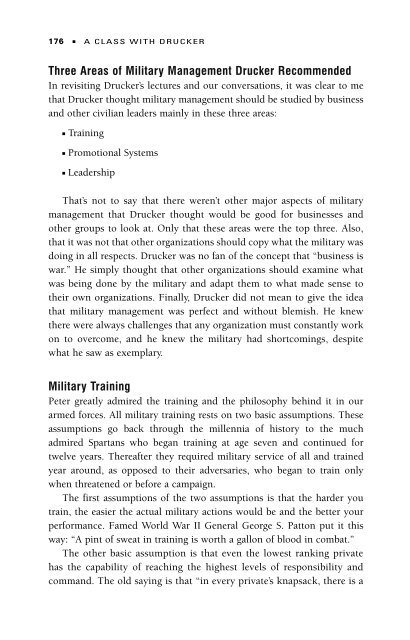A Class with Drucker - Headway | Work on yourself
A Class with Drucker - Headway | Work on yourself
A Class with Drucker - Headway | Work on yourself
Create successful ePaper yourself
Turn your PDF publications into a flip-book with our unique Google optimized e-Paper software.
176 ■ A CLASS WITH DRUCKER<br />
Three Areas of Military Management <str<strong>on</strong>g>Drucker</str<strong>on</strong>g> Recommended<br />
In revisiting <str<strong>on</strong>g>Drucker</str<strong>on</strong>g>’s lectures and our c<strong>on</strong>versati<strong>on</strong>s, it was clear to me<br />
that <str<strong>on</strong>g>Drucker</str<strong>on</strong>g> thought military management should be studied by business<br />
and other civilian leaders mainly in these three areas:<br />
■ Training<br />
■ Promoti<strong>on</strong>al Systems<br />
■ Leadership<br />
That’s not to say that there weren’t other major aspects of military<br />
management that <str<strong>on</strong>g>Drucker</str<strong>on</strong>g> thought would be good for businesses and<br />
other groups to look at. Only that these areas were the top three. Also,<br />
that it was not that other organizati<strong>on</strong>s should copy what the military was<br />
doing in all respects. <str<strong>on</strong>g>Drucker</str<strong>on</strong>g> was no fan of the c<strong>on</strong>cept that “business is<br />
war.” He simply thought that other organizati<strong>on</strong>s should examine what<br />
was being d<strong>on</strong>e by the military and adapt them to what made sense to<br />
their own organizati<strong>on</strong>s. Finally, <str<strong>on</strong>g>Drucker</str<strong>on</strong>g> did not mean to give the idea<br />
that military management was perfect and <str<strong>on</strong>g>with</str<strong>on</strong>g>out blemish. He knew<br />
there were always challenges that any organizati<strong>on</strong> must c<strong>on</strong>stantly work<br />
<strong>on</strong> to overcome, and he knew the military had shortcomings, despite<br />
what he saw as exemplary.<br />
Military Training<br />
Peter greatly admired the training and the philosophy behind it in our<br />
armed forces. All military training rests <strong>on</strong> two basic assumpti<strong>on</strong>s. These<br />
assumpti<strong>on</strong>s go back through the millennia of history to the much<br />
admired Spartans who began training at age seven and c<strong>on</strong>tinued for<br />
twelve years. Thereafter they required military service of all and trained<br />
year around, as opposed to their adversaries, who began to train <strong>on</strong>ly<br />
when threatened or before a campaign.<br />
The first assumpti<strong>on</strong>s of the two assumpti<strong>on</strong>s is that the harder you<br />
train, the easier the actual military acti<strong>on</strong>s would be and the better your<br />
performance. Famed World War II General George S. Patt<strong>on</strong> put it this<br />
way: “A pint of sweat in training is worth a gall<strong>on</strong> of blood in combat.”<br />
The other basic assumpti<strong>on</strong> is that even the lowest ranking private<br />
has the capability of reaching the highest levels of resp<strong>on</strong>sibility and<br />
command. The old saying is that “in every private’s knapsack, there is a


